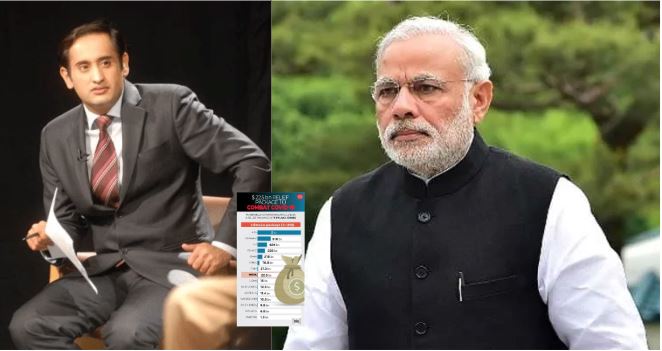The Data Intelligence Unit (DIU) of India Today is knows for attractive, provocative, and sometimes ‘misleading’ graphics it publishes. The DIU is a highly regarded department of media behemoth, and almost all popular journalists of the group share its graphics blindly, without any cross check.
After the Modi government announced ‘welfare package’ to support the poor who have lost livelihoods due to Coronavirus lockdown, the DIU of India Today group made a graph comparing the amount relief packages announced across the world. And many popular journalists of the group like Rahul Kanwal, Geeta Mohan shared this graphic.
Tweeting about the graphic Rahul Kanwal said, “Government sources say a stimulus package is in the works. Meanwhile, @IndiaToday Data Intelligence Unit looks at how today’s economic relief compares with what’s been announced by other countries so far.”
Government sources say a stimulus package is in the works. Meanwhile, @IndiaToday Data Intelligence Unit looks at how today’s economic relief compares with what’s been announced by other countries so far. pic.twitter.com/ZxWVeIM6cv
— Rahul Kanwal (@rahulkanwal) March 26, 2020
The graphic compared the ‘welfare package’ announced by the Indian government to those announced in other countries with much bigger economic size and 30 times higher per capital income.
The fundamentals of data analysis is that the metric on which variable is being compared must be same or at least comparable. Economics is all about comparative analysis, the data must be put in the right context otherwise one might reach an utterly misleading conclusion.
But the DIU of India Today threw all these logic under the bus and came out with an ultra-simplistic and utterly misleading graphic, on which its journalists received criticism from economists and were trolled by commoners.
The ‘apples with oranges’ comparison by India Today forced this writer to respond to Rahul Kanwal’s tweet, and replied, “The stupidity of India Today’s DIU is startling. 1) Indian economy is almost 8 times lower than that of US. 2) India is not as severely hit as European countries. 3) This is welfare package; the relief package for industry is yet to be announced.”
The stupidity of India Today's DIU is startling.
1) Indian economy is almost 8 times lower than that of US.
2) India is not as severely hit as European countries.
3) This is welfare package; the relief package for industry is yet to be announced.
— Amit Agrahari (@Amit_Agrahari94) March 26, 2020
“Oh no! As if corona wasn’t bad enough, data intelligence unit returns! India Today, pls save us from this calamity,” tweeted one user who goes as Joy.
Oh no! As if corona wasn't bad enough, data intelligence unit returns! India Today, pls save us from this calamity.
— Joy (@joyasian) March 26, 2020
“How can you compare the purchasing parity of US and India? Which foolish Economist in your channel suggested this s? Comparing an Apple and an Orange,” tweeted another use Suresh Kochattil.
How can you compare the purchasing parity of US and India? Which foolish Economist in your channel suggested this s? Comparing an Apple and an Orange.
— Suresh Kochattil (@kochattil) March 26, 2020
“There are so many things wrong about this chart that one can write a full thesis on it. This “Data Intelligence Unit” neither understands Data, nor has any Intelligence and certainly doesn’t understand Units. Indian journalists never surprise,” tweeted Ram.
https://twitter.com/ramprasad_c/status/1243181118398087168
“Not very intelligent. #PerCapitaGDP #PPP,” tweeted Shamika Ravi, former member of Prime Minister Economic Advisory Council.
Not very intelligent. 🤦🏽♀️#PerCapitaGDP #PPP https://t.co/Z9bZSH7QOZ
— Prof. Shamika Ravi (@ShamikaRavi) March 26, 2020
In order to downplay the welfare measures announced by the government, India Today DIU shows that India ranks 8th in terms of relief package amount with just 22.5 billion dollars package. The DIU kept all the other variables like purchasing power parity, size of the economy, severity of the problem aside.
This is not the first time when India Today Group has done such ‘apples with oranges’ comparison. Earlier, TheLallantop.com, a news & opinion website, shared a video which claims that ‘Narendra Modi’ is the Prime Minister who has borrowed the most from the World Bank’.
The video also claims that in the last four and a half years of Modi government, country’s debt increased by 49 percent. The video presenter was comparing absolute number while the right macroeconomic variable to measure the debt of any country is the debt to GDP ratio. So the debt number, as the video claims to, have increased to Rs 82, 03,253 crores with the corresponding amount till June 2014 being Rs 54, 90,763 crore, leads to a misleading conclusion. India’s debt to GDP ratio actually declined under Modi government from 47.09 percent in 2012 to 45.11 percent in 2017.
The India Today Group, in order to remain the fastest and number one channel, makes mistakes; and sometimes resorts to ‘apples with oranges’ comparison in order to sensationalize the story and attract more eyeballs.
